|
|
|
|
|
 |
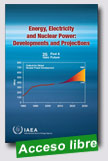 |
Energy, Electricity and Nuclear Power Development: Status and Trends 25 Years in the Past and the Future
IAEA, 2007, 77 p.
This publication describes, for Member States, energy experts, the media and the general public, the global and regional history of nuclear power between 1980 and 2005 as reflected in the data collected by the IAEA of the power reactor information system (PRIS) and the reference data series 1 and 2 (RDS-1, RDS-2) on the construction and operation of nuclear power plants. In this publication history is compared with IAEA projections during the same period, and the latest IAEA
|
projections are presented to cover both the past and the future quartercenturies.
Extraído de: http://www-pub.iaea.org/MTCD/publications/PubDetails.asp?pubId=7791
|
 |
 |
Radiological Dispersal Device (RDD)
First Responder's Guide—The First 12 Hours
Conference of Radiation Control Program Directors Inc, September 2006, 102 p.
A radiological dispersal device (RDD) or dirty bomb is a mix of explosives, such as dynamite, with radioactive powder or pellets. When the dynamite or other explosives are set off, the blast carries radioactive material into the surrounding area. The activities that take place in the first 12 hours are critical.
The RDD Handbook is now available online at no charge and on CD for $10, in addition to the nicely bound book, which is available for $30. |
|
Extraído de: http://www.crcpd.org/RDD.htm
Handbook: http://www.crcpd.org/RDD_Handbook/RDD-Handbook-ForWeb.pdf
|
 |
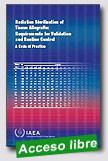 |
Radiation Sterilization of Tissue Allografts: Requirements for Validation and Routine Control: A Code of Practice
IAEA, 2007, 55 p.
This publication contains internationally agreed recommendations and guidelines for the safe use of ionizing radiation as a sterilization procedure for tissue allografts. The recommendations have been produced by the IAEA, with the help and approval of the main professional associations of tissue banks in North America, Europe and Latin America, as well as experts in all aspects of radiosterilization and transplantation procedures. The publication covers the |
recommended qualifications of tissue bank facilities, tissue donors and tissue processing and preservation procedures as well as the maintenance of validation of the pre-sterilization and sterilization processes. Also covered are the quality, safety and clinical application of tissue allografts, the documentation and certification procedures, management and control issues, ways of establishing a sterilization dose, and worked examples.
Extraído de: http://www-pub.iaea.org/mtcd/publications/PubDetails.asp?pubId=7657
|
 |
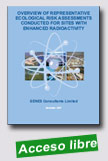 |
An overview of a selection of representative ERAs (Ecological Rik Assessments) was completed for a wide range of activities and sites at various locations throughout the world. The ERAs considered in this review include studies representative over the full range of nuclear fuel cycle activities from uranium mining through nuclear power generation. Sites involving enhanced levels of naturally occurring radioactive materials (NORM), the |
|
management and disposal of radioactive wastes, and the impacts of the Chernobyl nuclear accident are also considered. Different types of ecosystems (terrestrial, freshwater and marine aquatic environments) were considered in the selection of these representative ERAs.
Extraído de: http://www.world-nuclear.org/reference/pdf/wna-senes-1107.pdf
|
 |
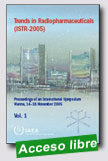 |
Trends in Radiopharmaceuticals. Proceedings of an International Symposium
IAEA Proceedings Series, 2007, 408 p.
The growth of nuclear medicine depends on advances in the development and discovery of radiopharmaceuticals as well as in the improvement of instrumentation. This international symposium was organized in order to provide scientists and professionals working in the field of radiopharmaceuticals and related sciences an opportunity to present their key research to an international audience. The symposium covered developments across the entire spectrum of >
|
radiopharmaceuticals chemistry, starting with radionuclide production, radiochemical processing, manufacturing and quality control of radiopharmaceuticals, latest advances in radiopharmaceuticals research, GMP and regulatory aspects. The invited papers and the oral representations are published in this book, and the papers presented in the poster session are compiled in CD format and attached at the back of the proceedings.
Extraído de: http://www-pub.iaea.org/mtcd/publications/PubDetails.asp?pubId=7656
|
 |
 |
Plan de estudios y capacitación para la formación de RTT (radioterapeutas/técnicos en radiología terapéutica)
IAEA Training Course Series No. 25, 2007, 82 p.
El número de pacientes con cáncer esta aumentando rápidamente en los países en desarrollo. La radioterapia es un componente fundamental en el tratamiento moderno del cáncer, pero desafortunadamente no es accesible para la mayoría de los pacientes en estos países. El Organismo Internacional de Energía Atómica (OIEA) ha venido prestando asistencia a los Estados Miembros en la creación, el funcionamiento y el mejoramiento de servicios de radioterapia. Además de la
|
|
capacitación en radioncología destinada a médicos y especialistas en física médica, estas actividades también abarcan la capacitación de los profesionales (conocidos en distintos países como radioterapeutas, técnicos en radiología o radiografía terapéutica, manipuladores, etc.) que se encargan de la utilización efectiva de las máquinas de radioterapia para el tratamiento de los pacientes. La escasez de esos profesionales bien capacitados representa un grave obstáculo para el acceso de los pacientes oncológicos a la radioterapia.
Las actividades de enseñanza y capacitación financiadas por el OIEA abarcaban a menudo el envío de RTT al extranjero, lo cual entrañaba costos considerables y el riesgo de “fuga de cerebros”. Si bien en muchos países de África y Asia la capacitación de RTT aún está en sus comienzos, será fundamental contar con programas de capacitación a nivel nacional y subregional para satisfacer las necesidades actuales y futuras de profesionales bien capacitados. Para abordar este problema, los coordinadores de proyectos del AFRA y el ACR decidieron elaborar un plan de estudios armonizado, que abarcara unos contenidos mínimos y aceptables, para la enseñanza y capacitación de RTT.
A tal efecto, se estableció un grupo de trabajo integrado por representantes de las dos regiones y por expertos internacionales, que redactó la primera versión del presente documento en Mauricio en 2002. Posteriormente, este programa fue ensayado en un taller del AFRA dedicado a la “formación de capacitadores”, que se celebró en Marruecos en 2003, y luego fue aprobado por los coordinadores de proyectos del AFRA y el ACR.
La presente guía de capacitación está destinada a todos los profesionales y administradores dedicados a la capacitación de RTT y su objetivo es proporcionar un marco común y coherente. También se incluyen formularios modelo de evaluación, que pueden adaptarse a las necesidades de cada país.
Extraído de: http://www-pub.iaea.org/MTCD/publications/PDF/TCS-25S_web.pdf
|
 |
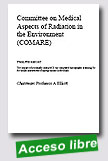 |
COMARE 12th Report: The impact of personally initiated X-ray computed tomography scanning for the health assessment of asymptomatic individuals
Health Protection Agency, Committee on Medical Aspects of Radiation in the Environment (COMARE), December 2007, 83 p.
Scanning of the asymptomatic individual by using a computed tomography (CT) X-ray machine is a practice that has implications for public health, despite the fact that CT scanning of the asymptomatic individual may provide benefits to that person. The committee has reviewed the literature regarding both the benefit and detriment associated with CT scanning in
|
the health assessment of asymptomatic individuals. We have considered the detriment caused by radiation from the CT scan but also the subsequent psychological effects and potential physical detriment from further investigations. Furthermore, we have considered the economic implications for the NHS which may become liable for further tests and examinations. While reviewing this type of practice, alternative techniques using lower doses of ionising radiation or non-ionising radiation have been considered.
COMARE recommends that regulation of these commercial CT services should be reviewed. We also recommend that clients should be provided with comprehensive information regarding dose and risk of the CT scan, as well as rates of false negative and false positive findings. Commercial CT services should have well developed and confidential mechanisms for integrating examination results into an established care pathway. Scans and data relating to any individual should be in formats consistent with national NHS IT programmes. We have also recommended that any individual displaying symptoms and requesting a CT scan from a commercial service should not be scanned and should be referred back to their GP. There is a regulatory requirement that all medical exposures using ionising radiation should be optimised, and from our review it is not possible to optimise exposure parameters for CT scans of the whole of the body, and we have strongly recommended that services offering whole body CT scanning of asymptomatic individuals should discontinue to do so. In addition, CT should not be used in assessment of spinal conditions, body fat and osteoporosis in asymptomatic individuals.
Scanning of three specific anatomical regions have been considered in detail in this report. We have concluded that there is no evidence that CT scanning for lung conditions is of benefit. However, cardiac CT scanning has been shown to have value for predicting cardiovascular risk and similarly CT colonography has the potential to detect small lesions. Both cardiac CT scanning and CT colonography should only be carried out in certain asymptomatic individuals.
Extraído de: http://www.comare.org.uk/12thReportPressRelease.htm
|
|
|
|
|
| |
|
